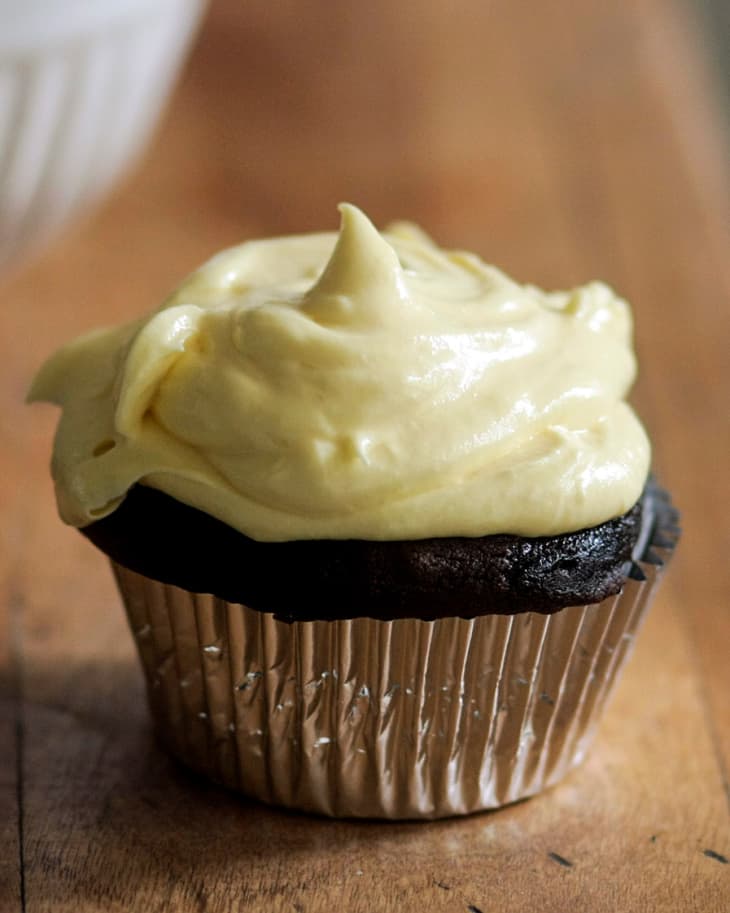How To Make a Sexy, Silky French Buttercream Frosting

There are buttercreams made with butter and powdered sugar, and there are buttercreams made with butter and egg whites. But for the most silky, decadent buttercream of all, you must try this French buttercream made with egg yolks.
Back when I was a pastry chef, I used to make buttercream by the gallon in a huge industrial mixer that stood in the corner and made the floor shake with its vigorous beating. We used this buttercream on all our layer cakes, from simple devil’s food to the most elaborate wedding cake. It’s based on a recipe from the first volume of Julia Child’s Mastering the Art of French Cooking with a few minor adjustments.
Buttercreams made with egg yolks take the richness factor up a few notches, turning it into a silky and sexy, but not-too-sweet, way to frost your cakes. You can pipe decorations with this buttercream, but it is a little looser than egg white or powdered sugar variations so expect softer, more billowy results.
I recommend using very high quality eggs, which often have deep orange yolks and will make a beautiful, soft yellow buttercream. The hot sugar syrup (238°F) added during mixing cooks the egg yolks a bit, but not enough to pasteurize them. If you’re being super cautious about raw eggs, then you may not want to use this recipe.
A stand mixer really comes in handy here, especially when pouring the hot sugar syrup into the egg yolks, but a hand mixer will do in a pinch. I do not recommend making this by hand unless you have very well-developed arm muscles! If after you’ve added all of the butter, the buttercream is too loose or grainy, try any one of these tips from Emma to fix it up.
Temperature is the key factor with this recipe. The egg-sugar mixture should be absolutely cool before you begin adding the butter, and the butter should be just slightly softened, just a little cooler than room temperature. You can test this by pressing on a piece with your finger. It should give enough for you to press into it, but it should take some effort. Under no circumstances should you melt the butter or expose it to anything warmer than room temperature. Melting the butter irrevocably changes the texture of the butter, separating the solids from the fat.
The finished buttercream can be stored for a few days in the refrigerator, but you will need to allow for time for it to come to room temperature before you can use it to frost cakes or cupcakes. Do not heat it up as this causes the butter to melt and the buttercream to break.
One last thing — don’t toss out the whites! If you don’t have an immediate use for them, cover and store in your refrigerator for a few days or freeze them for later use.
How To Make Silky French Buttercream
Makes about 2 cups
Nutritional Info
Ingredients
- 1 cup
(2 sticks) unsalted butter
- 2/3 cup
white sugar
- 3 tablespoons
water
- 5
large egg yolks
Pinch of salt
- 1 teaspoon
vanilla
Equipment
Small sauce pan
Candy thermometer
Stand mixer (or hand mixer)
Measuring cups and spoons
Instructions
Prep the butter. Unwrap the butter and cut it into large pieces, about 8 per stick. Leave on counter. If your kitchen is particularly cool, you may want to do this about 15 minutes ahead of time. (If your butter is frozen, thaw in the fridge overnight before using.)
Make the syrup. Combine the sugar and water in the small saucepan and place on the stove over a medium flame.
Beat the yolks. While the syrup is coming up to temperature, add the yolks and pinch of salt to the bowl of a stand mixer fitted with the whisk attachment. Whisk on high speed until pale and thick.
Add the syrup. When the syrup reaches the softball stage (238°F) remove from heat. With the mixer on low speed, slowly add the syrup to the yolks to avoid splattering the syrup on the beaters. Stop pouring every 10 seconds or so and increase the speed to high, then switch it to low and drizzle in more syrup. Do this until all the syrup is incorporated.
Beat until cool. After all the syrup has been incorporated, beat on high speed until the mixture has cooled to room temperature. This can take about 10 minutes.
Add the butter. When the mixture and the bowl no longer feel warm, switch to the paddle attachment and start adding the butter one cube at a time, mixing well in-between each addition.
Add vanilla. Add the vanilla (or other flavoring) and continue to beat until the buttercream is smooth and slightly stiff.
Recipe Notes
You can add other flavorings besides vanilla such as 2 tablespoons of brandy or strong coffee, peppermint extract, etc.
For chocolate buttercream: Melt 1 cup of semi or bittersweet chocolate chips in 2 tablespoons of hot coffee or brandy. Stir to combine and cool to room temperature. Add to the buttercream and beat well.
Want more smart tutorials for getting things done around the home?
See more How To posts
We’re looking for great examples of your own household intelligence too!
Submit your own tutorials or ideas here!
(Images: Dana Velden)
